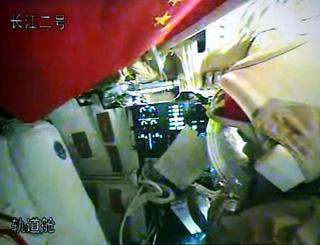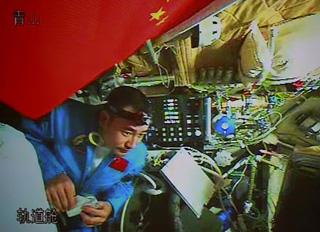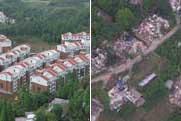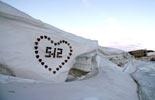China
Chinese trio´s first day of space adventure
Source: xinhua | 09-27-2008 09:26
Special Report: Shenzhou-7 Manned Space FlightBEIJING, Sept. 26 (Xinhua) -- The sun always rises. Twenty-four hours into their space adventure, the three Chinese taikonauts on board the Shenzhou-7 spaceship have witnessed sunrise and sunset for 16 times in their 680,000-kilometer journey.
 |
| Chinese taikonauts Zhai Zhigang and Liu Boming try their space suits in the orbit module of the Shenzhou-7 spacecraft, in this video grab taken on Sept. 26, 2008. The Shenzhou-7 spacecraft, which blasted off at 9:10 p.m. Thursday at the Jiuquan Satellite Launch Center in northwest China's Gansu Province, has functioned well as planned. (Xinhua/Zha Chunming) |
Despite a challenging mission slated on Saturday -- the nation's first attempt on a space walk, the trio, Zhai Zhigang, Liu Boming and Jing Haipeng, kept "quite relaxed and spirited" since they were sent into orbit at 9:10 p.m. Thursday, officials with the Beijing Aerospace Control Center (BACC) said.
EATING
Since Shenzhou-7 blasted off from the Jiuquan Satellite Launch Center in northwest Gansu Province, the three men, all aged 42, have had three meals over the past 24 hours.
Compared with their predecessors in the previous two missions of the country's manned space program, the Shenzhou-7 taikonauts are quite spoiled with a spicy 80-dish menu.
Their nutritionists have disclosed that their choices range from Kung Pao Chicken, deshelled shrimp to frozen dry fruits. For vinegar-loving Jing, the seasoning is well at hand, as various seasoning and sauces are provided on board. Jing is from northern Shanxi Province, where vinegar is a favorite condiment for locals.
Compared with Jing, Nie Haisheng, an astronaut on the Shenzhou-6 mission in 2005, was not that lucky. "I missed very much my favorite spicy foods and garlic sauce during my flight," Nie recalled.
What's more, the Shenzhou-7 taikonauts will not need to worry for half-cooked rice as Nie ate in his mission. The food heater onboard Shenzhou-7 has a stronger electricity supply than that on Shenzhou-6 as it is connected to the main power supply, which will make sure their rice can be fully cooked.
 |
| Chinese taikonaut Zhai Zhigang tries a bite on his food in the orbit module of the Shenzhou-7 spacecraft, in this video grab taken on Sept. 26, 2008. The Shenzhou-7 spacecraft, which blasted off at 9:10 p.m. Thursday at the Jiuquan Satellite Launch Center in northwest China's Gansu Province, has functioned well as planned. (Xinhua/Zha Chunming) |
SLEEPING
Monitoring video at the BACC showed that Jing Haipeng was sleeping in the re-entry module at noon on Friday. With two hands in front of the chest, Jing slept quietly.
Staff at the BACC told Xinhua that Jing was actually taking a nap. The right place to sleep was the orbital module, where sleeping bags were placed.
The sleeping bags, made of warm fabrics and cashmere, are hooked on the wall of the orbit module. Astronauts only need to get into the sleeping bag and fasten the zipper if they want to sleep.
Under the low-gravity condition, astronauts may sleep standing, sitting or lying. When they sleep, they have to put their arms inside the sleeping bag and tie their hands on their chests, so as not to touch equipment switches accidentally.



